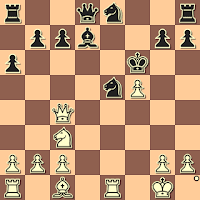
I was recently challenged to a game by an online player new to, and excited about, the Jerome Gambit (1.e4 e5 2.Nf3 Nc6 3.Bc4 Bc5 4.Bxf7+). He took White, and I decided to play my favorite defense, although, in retrospect, I could have chosen something that would have allowed him to bash me all over the board...
Anyhow, I probably should have suggested "Jerome Gambit: What About the Rook?" as pre-game precautionary reading.
NN - perrypawnpusher
Chess.com, 2021
1.e4 e5 2.Nf3 Nc6 3.Bc4 Bc5 4.Bxf7+
4...Kxf7 5.Nxe5+ Nxe5 6.Qh5+ g6 This move often leads to either the Blackburne or Whistler Defense, and in either case there will be a dangerous offer of a Rook.
7.Qxe5 Qe7
Whistler's Defense.
8.Qxh8
I have touched upon the dangers of this move in the aptly titled post "There Are Some Risks We Should Not Take."
8...Qxe4+ 9.Kf1 Qh4
I recommended this move in a blog post about 6 years ago. According to The Database it has been played only twice, since, with effect.
A couple of years ago I saw it in analysis in one of the Hindi Chess Videos - see "Jerome Gambit: Interesting Sideline".
10.g3 Qh3+ 11.Kg1 Qe6
A blunder, after which the game should only be drawn. Instead, 11...b6 (or 11...b5) would lead to checkmate, once Black's Bishop gets on the a8-h1 diagonal.Also seen:
11...d5 12.Qe5 Bd6 13.Qxd5+ Be6 14.Qf3+ Nf6 15.Qg2 Qh5 16.Nc3 c6 17.d3 Bh3 18.Be3 Bxg2 19.Kxg2 Re8 20.Rae1 Nd5 21.Nxd5 Qxd5+ 22.Kg1 Bc5 23.b3 Qf3 24.h4 Bxe3 25.fxe3 Rxe3 26.Rxe3 Qxe3+ 27.Kh2 Qf2+ 28.Kh3 h5 29.Rh2 Qf1+ 30.Rg2 Kf6 31.d4 Kf5 32.Kh2 Kg4 33.c3 Kf3 34.Rc2 Qd3 35.Rg2 Qxc3 36.g4 Qxd4 37.gxh5 Qxh4+ 38.Kg1 gxh5 39.a4 Qe1+ 40.Kh2 h4 41.a5 Qf1 42.Rc2 Qe1 43.Rg2 h3 44.Rc2 Qg3+ 45.Kh1 Kg4 46.b4 Qf3+ 47.Kh2 Qf4+ 48.Kh1 Qe4+ White resigned, ZahariSokolov - MadonnaFn, FICS, 2015; and
11...b512.d4 Bb7 13.Qxh7+ Qxh7 14.Nd2 Qh3 15.f3 Bxd4 checkmate, ZahariSokolov - ekwador, FICS, 2017.
12.Kg2
I was shocked to see this move (the time control was 3 days per move, so the play was not continuous) because I had set the position up wrong, and thought that my opponent had played 11.Ke1, not 11.Kg1.
Instead of the text, White had 12.Qxh7+ Kf8 13.d4, forcing Black to consider a draw by repetition, e.g. 13...Qe1+ 14.Kg2 Qe4+ 15.Kg1 Qe1+ etc. Otherwise, Black can play on, down the exchange and a pawn.
Now Black can force checkmate.
12...Qe4+ 13.Kg1
Or 13.Kf1 Qxh1+ 14.Ke2 Qe4+ 15.Kf1 d5 16.Qxh7+ Kf8 17.Qxc7 Qh1+ 18.Ke2 Bg4+ 19.Kd3 Qf3 checkmate
Or 13.Kh3 d5+ 14.g4 Qxg4 checkmate
13...Qe1+ 14.Kg2 Qxf2+ 15.Kh3 d5+ 16.Kh4 Be7+ 17.Qf6+ Bxf6 checkmate
Now, I get to play the Jerome. I wonder what defense he will play?
























GM Smerdon,
I am working my way through your fascinating The Complete Chess Swindler, a topic that greatly appeals to me, from both a psychological perspective and as a matter of survival: I have been researching and playing the worst chess opening ever, the Jerome Gambit (1.e4 e5 2.Nf3 Nc6 3.Bc4 Bc5 4.Bxf7+), for a couple of decades, and have come to realize that any success whatsoever has been due to swindles. (I immediately apologize to the ghost of Frank Marshall and other masters, living and dead.)
Many thanks for your hard work.
Hi Rick. I recently came across the Jerome Gambit on YouTube. It’s….quite something!